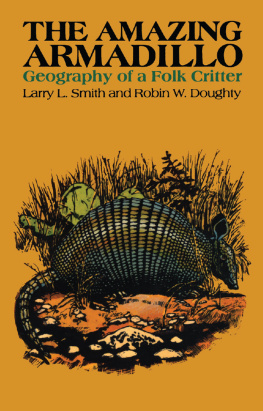Larry L. Smith - The Amazing Armadillo: Geography of a Folk Critter
Here you can read online Larry L. Smith - The Amazing Armadillo: Geography of a Folk Critter full text of the book (entire story) in english for free. Download pdf and epub, get meaning, cover and reviews about this ebook. year: 1984, publisher: University of Texas Press, genre: Art. Description of the work, (preface) as well as reviews are available. Best literature library LitArk.com created for fans of good reading and offers a wide selection of genres:
Romance novel
Science fiction
Adventure
Detective
Science
History
Home and family
Prose
Art
Politics
Computer
Non-fiction
Religion
Business
Children
Humor
Choose a favorite category and find really read worthwhile books. Enjoy immersion in the world of imagination, feel the emotions of the characters or learn something new for yourself, make an fascinating discovery.
- Book:The Amazing Armadillo: Geography of a Folk Critter
- Author:
- Publisher:University of Texas Press
- Genre:
- Year:1984
- Rating:4 / 5
- Favourites:Add to favourites
- Your mark:
- 80
- 1
- 2
- 3
- 4
- 5
The Amazing Armadillo: Geography of a Folk Critter: summary, description and annotation
We offer to read an annotation, description, summary or preface (depends on what the author of the book "The Amazing Armadillo: Geography of a Folk Critter" wrote himself). If you haven't found the necessary information about the book — write in the comments, we will try to find it.
This informative book traces the spread of the nine-banded armadillo from its first notice in South Texas late in the 1840s to its current range east to Florida and north to Missouri.
The Amazing Armadillo: Geography of a Folk Critter — read online for free the complete book (whole text) full work
Below is the text of the book, divided by pages. System saving the place of the last page read, allows you to conveniently read the book "The Amazing Armadillo: Geography of a Folk Critter" online for free, without having to search again every time where you left off. Put a bookmark, and you can go to the page where you finished reading at any time.
Font size:
Interval:
Bookmark:
THE AMAZING ARMADILLO
THE AMAZING ARMADILLO
Geography of a Folk Critter
by Larry L. Smith and Robin W. Doughty

UNIVERSITY OF TEXAS PRESS
AUSTIN
Illustrations by Charles Shaw
Copyright 1984 by the University of Texas Press
All rights reserved
Printed in the United States of America
First edition, 1984
Requests for permission to reproduce material from this work should be sent to:
Permissions
University of Texas Press
Box 7819
Austin, Texas 78713
LIBRARY OF CONGRESS CATALOGING IN PUBLICATION DATA
Smith, Larry Lane.
The amazing armadillo.
Bibliography: p.
1. Nine-banded armadillo. 2. Armadillos. I. Doughty, Robin W. II. Title.
QL737.E23S64 1984 599.31 84-7444
ISBN 0-292-70375-9
ISBN 978-0-292-74944-3 (e-book)
ISBN 9780292749443 (individual e-book)
Introduction
Landscapes and the assemblage of plants and animals that give them distinction are in constant flux. Earthquakes, tornadoes, and other natural hazards cause sudden alterations to the face of the earth. Human alterations are far more extensive and varied, sometimes conspicuous, sometimes subtle. The appearance of farms and growth of cities represent the unique powers of humans to alter environments over the long term.
Animals and plants continually change their ranges and numbers and demonstrate the inherently dynamic character of biotic assemblages. Specialist organisms, that is, ones having narrow and well-defined food preferences, reproductive behavior, or other activities, may disappear in human-altered landscapes. Generalist organisms able to exploit disrupted habitats may replace them.
The English or house sparrow and European starling are well-studied examples of birds that have benefited from transport and release by humans. The cattle egret and collared dove have expanded their ranges by occupying the habitats created by agriculture and settlement. Similarly, deer, rabbits, foxes, and cats are among the scores of different mammals that have thrived in disturbed landscapes. North Americas coyote, for example, has lived up to a reputation for being cunning and elusive and becoming widespread and numerous despite prolonged efforts to destroy it.
The nine-banded armadillo is another generalist mammal that has vigorously expanded its range and numbers during the past century. This oddity among North American mammals flourishes within the United States, although it arrived here less than 150 years ago with no fanfare and little comment. It has achieved no status as a game animal whose trophy or meat is highly esteemed, and there is little to celebrate about its appearance, movements, bearing, size, or coloration. Yet there is a keen and sizable interest in the armadillo, especially in Texas, its first home state. This book defines that interest, and also traces the vicissitudes of public opinion that first judged it to be more harmful than beneficial.
By 1900, this mobile and adaptable mammal had captured the interest of entrepreneurs who promoted armadillo shell-baskets as curios. Scientists specializing in genetic and medical research began to conduct extensive tests on the armadillo. In the last fifteen or twenty years, more and more Texans have increased their regard for this odd-looking mammal. Some lawmakers have described it as having human qualities. It is a true Texan, they say, tough, pioneering, adaptable, and it generously shares its habitation with others.
This book is about the perception and use of wild animals. It is important to document how attitudes toward animals change as people become interested in and familiar with their life histories and habits. In this sense, our book builds upon the earlier monograph by Edward R. Kalmbach, The Armadillo: Its Relation to Agriculture and Game, published by the Texas Game, Fish and Oyster Commission in 1943. Kalmbachs text looked closely at the economic significance of the nine-banded armadillo as a menace to crops and to ground-nesting game birds. Todays public has expressed affection for this mammal, not simply because it consumes injurious insects and benefits medical research. The intangible qualities of the armadillo that we tend to express in terms such as resourceful, generous, and humble are worth consideration because they reflect, albeit unconsciously, the values that we place on this species and other animals. Such interests and affections color our judgments about preserving or managing them.
This book is also about what the noted ecologist Charles Elton calls ecological explosions. His classic book, The Ecology of Invasions by Animals and Plants, focuses on the enormous increase in numbers of different organisms. We hear a great deal about animals under pressure, that is, threatened with extinction, but it is worth noting that numerical increases and expansions of range are also commonplace. The armadillo exemplifies an ecological explosion in the United States. We tend to ignore or disregard similar events because pests to forest products, or other undesirable animals such as alien species that flourish without natural predators, exemplify explosions that we could do well without.
The armadillo is an ecological success story. It is neither an important pest nor an animal that has relied exclusively on humans for transport and release. It continues to occupy new range in the American South. And from what we know, much of this expansion is due to the animals pioneering abilities. The armadillo prospers in changed environments. It constructs dens in brush-filled fields that cattle have overgrazed, and it feeds in suburban gardens and parks. It is true that people have given a fillip to its colonizing ability by shipping armadillos around the country. But, as in the case of the cattle egret, the precise significance of humans in the mammals overall distribution is difficult to determine. The armadillos abilities to adapt, colonize, and increase are evident.
Finally, this book is a contribution to a well-established research theme in geography, namely human activities in exploiting, conserving, and transporting organisms on the face of the earth. A considerable body of literature in American geography exists on animal-related topics, such as animals role in traditional societies and the economic, ecological, and public health problems associated with native and introduced species. We shall examine these problems and try to explain the factors responsible for the armadillos distribution and spread, the barriers to its dispersal, and its integration into folklore and popular culture.
reviews the treatment of this unique animal as a pest and predator. Negative judgments about the harm to game birds and crops changed after field research demonstrated that the armadillos food preferences were economically more beneficial than harmful. People became interested in keeping armadillos as unusual pets and in decorating their homes with baskets made from their shells. This chapter also describes the current medical research with armadillos that aims to develop a vaccine against Hansens Disease, or leprosy.
demonstrates how the growing interest in armadilloswatching them race, tasting their meat in festive cookoffs and barbecueshas enlarged the publics knowledge about the animal. Younger people have come to identify this harmless creature with a relaxed way of living exemplified by progressive country music. Consequently, musicians and artists and larger commercial interests have promoted this pocket dinosaur as a symbol of Texas and Texas living. The Lone Star origin of this fad for armadilliana has expanded to other urban centers across the nation, and more and more Americans are familiar with this addition to Americas native fauna.
Next pageFont size:
Interval:
Bookmark:
Similar books «The Amazing Armadillo: Geography of a Folk Critter»
Look at similar books to The Amazing Armadillo: Geography of a Folk Critter. We have selected literature similar in name and meaning in the hope of providing readers with more options to find new, interesting, not yet read works.
Discussion, reviews of the book The Amazing Armadillo: Geography of a Folk Critter and just readers' own opinions. Leave your comments, write what you think about the work, its meaning or the main characters. Specify what exactly you liked and what you didn't like, and why you think so.








